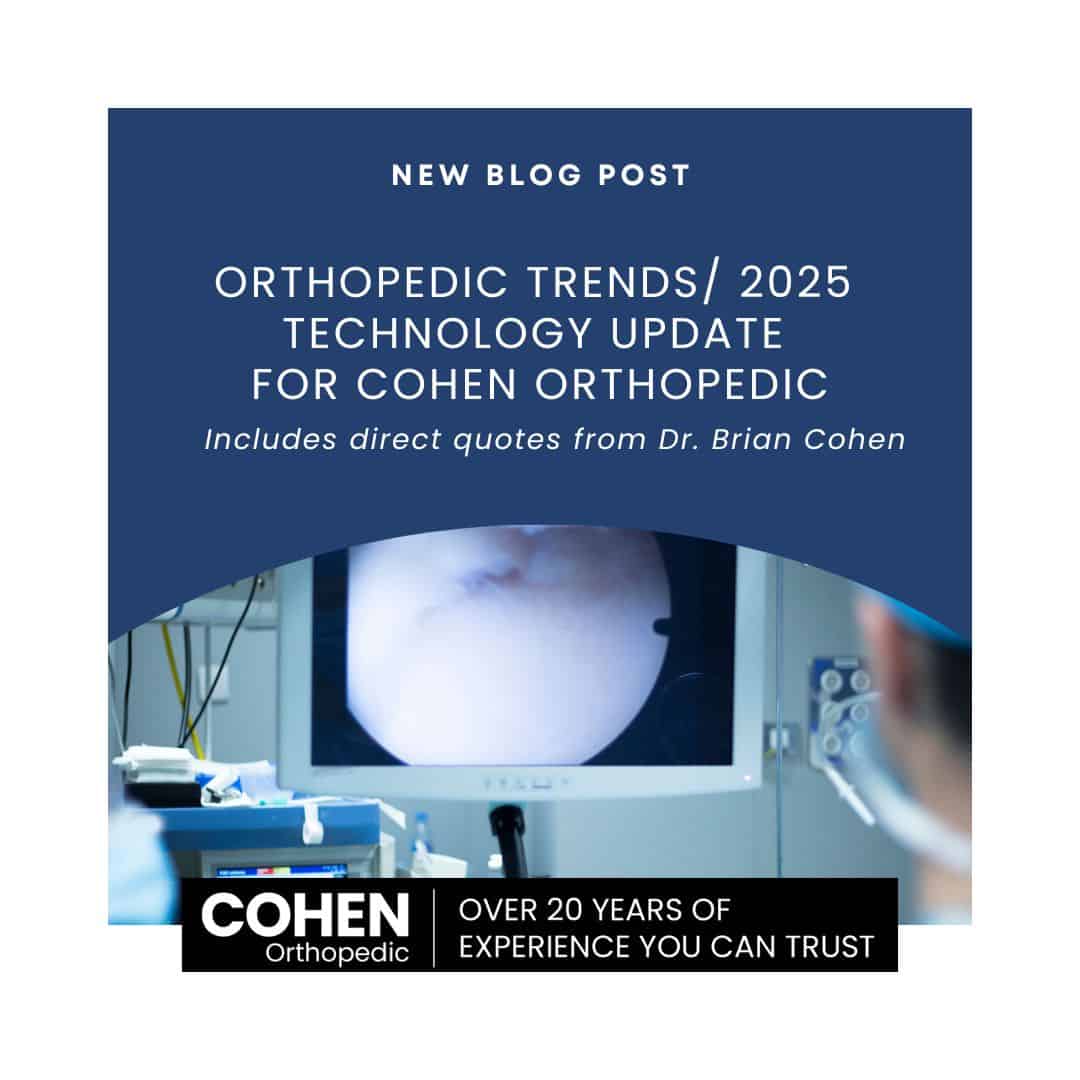Current Orthopedic Trends: Innovations and Advancements in Musculoskeletal Health

Orthopedics, the branch of medicine concerned with the diagnosis, treatment, prevention, and rehabilitation of musculoskeletal disorders, has seen remarkable advancements in recent years. As medical technology continues to evolve, so do the methods used to treat everything from joint degeneration and fractures to sports injuries and congenital deformities. Whether it’s the rise of minimally invasive procedures or breakthroughs in personalized care, the world of orthopedics is transforming at a rapid pace.
In this blog, we’ll explore some of the most exciting trends in orthopedics today, highlighting the technologies, treatments, and approaches that are shaping the future of musculoskeletal health.
1. Minimally Invasive Surgeries: A Shift Toward Precision
Minimally invasive orthopedic surgeries are gaining popularity as patients and surgeons alike seek solutions that reduce recovery times, minimize complications, and improve outcomes. These procedures involve smaller incisions, which means less tissue disruption and a quicker recovery process. Common minimally invasive orthopedic surgeries include:
- Arthroscopic Surgery: Used for joint issues, such as ACL tears, cartilage damage, and shoulder repairs, arthroscopy involves inserting a tiny camera (arthroscope) through small incisions to allow surgeons to repair the joint with minimal disruption.
- Endoscopic Spine Surgery: For patients with spine problems like herniated discs, endoscopic surgery offers a less invasive approach, allowing surgeons to remove damaged tissue with smaller incisions and less muscle disruption.
The trend toward minimally invasive techniques is driven by the desire to reduce patient pain and recovery time while maintaining or even improving surgical outcomes.
2. Robotics and Computer-Assisted Surgery: The Future of Precision
The integration of robotics and computer-assisted technology into orthopedic procedures has been a game changer. Robotic systems, such as the MAKO robotic system and Navio Surgical System, are now being used in joint replacement surgeries, particularly hip and knee replacements. These systems allow for incredibly precise bone cutting, accurate placement of implants, and custom-tailored surgeries based on each patient’s unique anatomy.
In addition, computer-assisted navigation is enhancing the accuracy of procedures like spine surgery, fracture repair, and total joint replacements. These tools help surgeons plan and execute operations with unprecedented accuracy, reducing the risk of complications and ensuring better long-term outcomes for patients.
3. Personalized Medicine: Tailoring Treatment Plans
The trend toward personalized medicine is making waves in orthopedics as clinicians move toward treatments tailored to the individual’s genetic makeup, lifestyle, and specific needs. One of the most exciting areas of development is in biomaterials and implant technology.
- 3D Printing: Orthopedic implants are becoming increasingly customized thanks to 3D printing technology. Surgeons can now print patient-specific implants and prostheses that fit perfectly with a patient’s anatomy, improving functionality and reducing the risk of complications.
- Biologics and Regenerative Medicine: Stem cell therapies, platelet-rich plasma (PRP) treatments, and tissue engineering are reshaping the treatment of soft tissue injuries, joint degeneration, and cartilage repair. These therapies promote healing by stimulating the body’s natural regenerative processes, offering promising alternatives to traditional surgery.
As we move forward, personalized treatments will become more common, with advancements in genetic testing and data analytics allowing for a more individualized approach to musculoskeletal care.
4. Non-Surgical Options: A Shift Toward Conservative Treatment
While surgery has traditionally been the go-to treatment for many orthopedic conditions, the emphasis on non-surgical treatments is growing, especially for conditions like osteoarthritis, back pain, and sports injuries. Several non-invasive treatments have been gaining traction:
- Physical Therapy and Rehabilitation: Exercise-based rehabilitation remains a cornerstone of orthopedic care. In recent years, more focus has been placed on functional rehabilitation that targets the patient’s specific lifestyle and functional goals, helping them return to activities they enjoy without relying on surgery.
- Cryoneurolysis and Shockwave Therapy: Techniques like cryoneurolysis, which involves freezing nerve tissue to block pain signals, and extracorporeal shockwave therapy (ESWT), which uses high-energy sound waves to promote healing, are becoming increasingly common alternatives to invasive procedures.
- Orthobiologics: As mentioned earlier, biologic treatments like stem cell therapy, PRP, and amniotic membrane injections are offering new hope for patients with degenerative joint disease or soft tissue injuries. These therapies harness the body’s natural healing abilities to repair damaged tissues and delay or avoid the need for surgery.
These non-invasive therapies focus on managing pain and improving function, offering patients a chance to recover without the risks and downtime associated with traditional surgeries.
5. Sports Medicine: Focus on Injury Prevention and Performance Enhancement
Sports medicine continues to evolve, not just in treating sports injuries but also in focusing on injury prevention and performance enhancement. More athletes and active individuals are turning to orthopedic specialists to prevent injuries before they occur.
- Wearable Technology: The use of wearable devices, such as motion sensors and biomechanical analysis tools, helps track an athlete’s movements, identifying potential stress points and biomechanical issues that could lead to injuries.
- Prehabilitation: Instead of waiting for an injury to occur, prehabilitation involves strengthening muscles and improving flexibility in anticipation of future physical activity. This trend is gaining popularity in professional sports, where preventing injuries is just as important as recovering from them.
Orthopedic surgeons are increasingly working with sports scientists to create rehabilitation plans that not only help athletes recover from injuries but also improve their performance and prevent future injuries.
6. Geriatric Orthopedics: Addressing the Needs of an Aging Population
As the global population ages, orthopedic care is increasingly focused on the elderly. Conditions like osteoarthritis, osteoporosis, and hip fractures are common in older adults, and there is a growing emphasis on treating these issues with a focus on quality of life and functional independence.
- Minimally Invasive Hip and Knee Replacements: Joint replacements are becoming more common in elderly patients, with advancements in surgical techniques that allow for quicker recovery and better functional outcomes.
- Osteoporosis Treatments: New medications and therapies to treat osteoporosis, such as bisphosphonates, denosumab, and abaloparatide, are helping to prevent fractures and improve bone health.
- Multidisciplinary Care: Geriatric orthopedics often involves a team-based approach, including physical therapists, occupational therapists, and geriatricians, to ensure comprehensive care that addresses the complexities of aging.
7. Artificial Intelligence (AI) and Machine Learning in Orthopedics
AI is making its way into nearly every aspect of healthcare, and orthopedics is no exception. Machine learning algorithms are now being used for:
- Diagnostic Support: AI-powered imaging tools help radiologists identify fractures, joint degeneration, and other musculoskeletal abnormalities more accurately and quickly than traditional methods.
- Predictive Analytics: AI is being used to predict patient outcomes based on data collected from medical histories, imaging, and other sources. This helps clinicians create more effective treatment plans and manage patient care more efficiently.
- Surgical Planning: AI is helping surgeons plan complex procedures by analyzing data from previous surgeries and patient outcomes, improving surgical precision and reducing the risk of complications.
Conclusion
The field of orthopedics is undergoing a transformation, driven by technological advancements, a shift toward personalized care, and an increasing focus on non-surgical treatments. From robotics and 3D-printed implants to AI-powered diagnostics and regenerative medicine, the future of musculoskeletal health looks brighter than ever. As these trends continue to evolve, patients will benefit from more effective, less invasive treatments, leading to quicker recoveries, better outcomes, and improved quality of life. Whether you’re dealing with a sports injury, joint pain, or age-related musculoskeletal conditions, the latest innovations in orthopedic care offer hope for a healthier, pain-free future.
Where is Cohen Orthopedic with these advancements?
(Includes direct quotes from Dr. Brian Cohen)
Our mission statement is to always, when possible, leverage technology to improve patient safety, experience and outcomes. “This will not change in 2025 or beyond,” states Dr. Cohen.
Cohen Orthopedic will continue to utilize the MAKO Robotics technology for total hips and knees and revision total hips and knees as we approach our 3000th MAKO surgery. Additionally, we will continue to utilize Atreon Orthopedics Rotium to improve the quality of the healing of tendon to bone as we do in rotator cuff, biceps, triceps, quadriceps and patella tendon repairs.
In 2024, we harnessed the power of biology to our ACL reconstructions by fertilizing the graft, as well as augmenting the reconstruction with an internal brace.
In 2025, our goal is to finalize the architectural plan and incorporate infection fighting technologies (Synexis and Clean Cube OR) for our new state of the art ASC/MOB.










